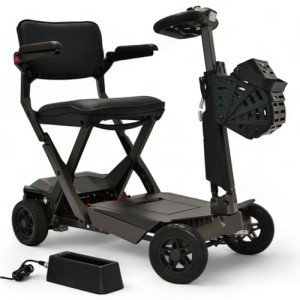What's Holding Back The Mobility Scooter Industry?

Understanding Mobility Scooters: A Comprehensive Guide
Mobility scooters have actually become an important tool for people who face mobility difficulties, supplying self-reliance and a means of transportation. They are developed to help users in navigating different surfaces, whether inside your home or outdoors, allowing them to engage more completely in everyday activities. This article will check out the types of mobility scooters, their functions, benefits, and considerations for possible users.
What is a Mobility Scooter?
A mobility scooter is a motorized lorry produced individuals with physical restrictions. It helps users preserve their mobility and independence, supplying an efficient ways of transportation over brief ranges. While they may look comparable to small electric cars, mobility scooters are typically powered by batteries, with controls designed for ease of use.
Types of Mobility Scooters
There are a number of types of mobility scooters readily available in the market, each developed to accommodate various needs and choices. Here's a breakdown of the most common types:
| Type of Mobility Scooter | Description | Best For |
|---|---|---|
| Three-Wheeled Scooters | These scooters use outstanding maneuverability and small turning radius however might do not have stability. | Indoor use and tight spaces. |
| Four-Wheeled Scooters | Frequently more stable than three-wheeled designs, these scooters are perfect for outdoor use. | All-terrain travel and outdoor activities. |
| Portable Scooters | Lightweight and collapsible, these scooters are designed for simple transportation. | Travelers and individuals with limited storage space. |
| Sturdy Scooters | Built for bigger users, these are robust and can handle heavier weights, typically equipped with better battery life. | Users requiring additional support and stability. |
| Feature-Rich Scooters | These may consist of innovative innovation such as Bluetooth connection, built-in GPS, and adjustable seating. | Tech-savvy users searching for convenience and convenience. |
Secret Features of Mobility Scooters
When selecting a mobility scooter, buyers should consider a number of vital features. The following list describes critical aspects that can significantly influence their experience:
- Weight Capacity: Understanding the scooter's weight limit is vital to guarantee security and performance.
- Battery Life: A longer battery life equates to more extended use between charges, which is crucial for lengthy journeys.
- Speed: Typical mobility scooters can reach speeds in between 4 to 8 miles per hour, but it's vital to choose one that fits the user's needs.
- Convenience: Look for adjustable seats, armrests, and backrests that enhance the overall riding experience.
- Portability: If taking a trip often, a lightweight and collapsible scooter is useful.
- Surface Capability: Some scooters are much better geared up for rough terrains, while others work best on smooth surfaces.
Benefits of Using Mobility Scooters
Mobility scooters offer numerous advantages that can substantially enhance users' lifestyle. These include:
Increased Independence
Lots of individuals who deal with mobility count on family or caregivers for transportation. Mobility scooters empower users to move about easily and perform errands on their own, promoting a sense of self-reliance and self-sufficiency.
Improved Quality of Life
Having the ability to travel unassisted can result in social engagement, enhanced psychological well-being, and overall much better lifestyle. Users can take part in social activities, visit family and friends, and explore their communities.
Cost-Effectiveness
Compared to other mobility help or services, mobility scooters can be more affordable. purchase mobility scooters can get rid of the need for expensive changes to homes or dependence on transport services.
Adjustability and Customization
Lots of mobility scooters feature choices for customization, making sure that users can customize them to best meet their individual needs.
Considerations Before Purchase
Before selecting the best mobility scooter, possible buyers ought to keep these factors to consider in mind:
- Lifestyle Needs: Assess how the scooter will fit into everyday routines, consisting of the frequency and places of use.
- Trial Rides: If possible, taking a few models for a test drive can assist determine convenience and maneuverability.
- Budget: Costs can vary commonly, so defining a budget plan upfront is essential.
- Service warranty and Service: Always think about the warranty provided and the schedule of customer care in case of repair work.
Frequently Asked Questions About Mobility Scooters
1. How quick do mobility scooters go?
Mobility scooters normally vary from 4 to 8 miles per hour, depending on the model and its power capability.
2. Are mobility scooters covered by insurance coverage?
Many insurance plans might cover part of the cost if a doctor recommends the scooter; nevertheless, policies differ considerably.
3. Can I drive a mobility scooter on the road?
This depends upon regional laws and regulations. In some areas, mobility scooters might be permitted on public roads, while in others, they are restricted to pathways and pathways.
4. How long does the battery last?
Battery life generally depends on the scooter design and kind of use. Common mobility scooter batteries can last anywhere from 6 to 12 miles on a single charge.
5. Are mobility scooters safe?
Mobility scooters are generally safe when used appropriately. It's important to familiarize oneself with the controls and run them responsibly.
Mobility scooters play an important role in the lives of people with mobility challenges. By comprehending the types, features, advantages, and considerations connected with these automobiles, users can make informed options. This can cause increased self-reliance, a much better lifestyle, and renewed access to the world around them. Whether for social trips, errands, or recreational activities, a mobility scooter can be a life-changing investment for many people.

